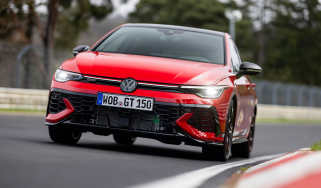Volkswagen Golf GTI 2025 review – the quintessential hot hatch improved but not perfected
The eighth VW Golf GTI is fast, capable and easy to live with, now with improved if not perfected HMI and driving dynamics
Life hasn’t been easy for the Mk8 Golf GTI. After the heights of the Mk7, which was superbly rounded and one of the best GTIs there’s ever been, things came tumbling down when Volkswagen decided that the Golf needed more digitisation and more screens to move forward into the current decade. We won’t beat what is a very dead horse here, but if you’ve ever tried to tap, poke and stroke your way around the eighth-gen Golf’s interface, you’ll know just how much of a blunder that was.
But it wasn’t just the HMI system. When it launched in 2019, the Mk8 Golf no longer felt like the class benchmark for quality, while as a hot hatch there was a sense that it had lost some of the polish, slickness and personality of its predecessor. Yes it was more powerful and could carry immense speed down a road, but it somehow wasn’t as satisfying to own, live with and drive as the Mk7.
Perhaps we would’ve looked at the Mk8 GTI more fondly if Hyundai hadn’t come out of nowhere to produce the outstanding i30 N a year earlier. In many ways Hyundai’s first hot hatch felt like a modern reincarnation of the Mk5 Golf GTI, with an addictive, pugnacious attitude and all the sensibilities you need in an everyday car. An archetypal hot hatch, in other words, and so much more exciting (and significantly cheaper) than the Golf. Shame you can’t order a new one anymore.
More reviews
Now Volkswagen is having another go at reclaiming the market it has traditionally been at or near the top of by launching an updated Mk8.5 GTI. Or, more accurately, one last go. An electric Mk9 Golf arrives later in the decade, which makes this the final combustion-engined GTI and one with enormous weight on its shoulders. No doubt there will be a number of run-out specials at some point to join this, which has already begun with the more powerful Clubsport, but for the Mk8 GTI to go out on a high, the base car needs to be good.
Indeed new for the 8 is a consistent GTI and GTI Clubsport hierarchy, the latter pairing a more potent version of the same EA888 engine to a bespoke chassis tune and styling.
Despite the overwhelmingly new look, the Mk8 has always shared much with the last best Golf GTI, the 7.5, from its basic MQB architecture to its powertrain – all purportedly sharpened, stiffened, and with more attention paid to the details.
Volkswagen Golf GTI: in detail
- > Engine and gearbox and technical highlights – A 261bhp figure is adequate, but a slick DSG and eLSD make the most of those horses
- > Performance and 0-60 time – A strong, broad torque curve helps, with good performance on paper and on the road
- > Ride and handling – Agile and balanced; adaptive dampers have an impressive range
- > MPG and running costs – On-paper MPG figures are good, and you’ll easily match them on longer runs
- > Interior and tech – The Mk8.5 is greatly improved, if not perfected; at least the driving position’s good
- > Design – Crisp detailing of the Mk8.5 doesn’t elevate it to Mk7-esque effortless coolness
The 8.5 is certainly stronger than the 8 in some key areas, but it isn’t a car transformed. Perhaps it doesn’t need to be, given the state of the dwindling petrol hot hatch market. At the GTI’s price point of £38,900 it sits in a different category to our favourite hot hatch, the £50,050 Civic Type R, while the likes of the Mercedes-AMG A35 (£46,000) and BMW M135 (£43,000) are a closer match for the Golf R and GTI Clubsport respectively.
Of what rivals remain, the Focus ST and updated Cupra Leon are probably the GTI’s nearest challengers, but as more makers succumb to emissions regulations and shift funding towards EVs, the competition pool will only shrink. Fitting, then, that the first hot hatch in the traditional sense will also be one of the last ones standing.
Volkswagen Golf GTI (Mk8.5) specs
| Engine | In-line 4-cyl, 1984cc, turbocharged |
|---|---|
| Power | 261bhp @ 6500rpm |
| Torque | 273lb ft @ 1600-4590rpm |
| Weight | 1454kg (180bhp/ton) |
| Tyres | Bridgestone Potenza S005 |
| 0-62mph | 5.9sec |
| Top speed | 155mph |
| Basic price | £38,900 |
























